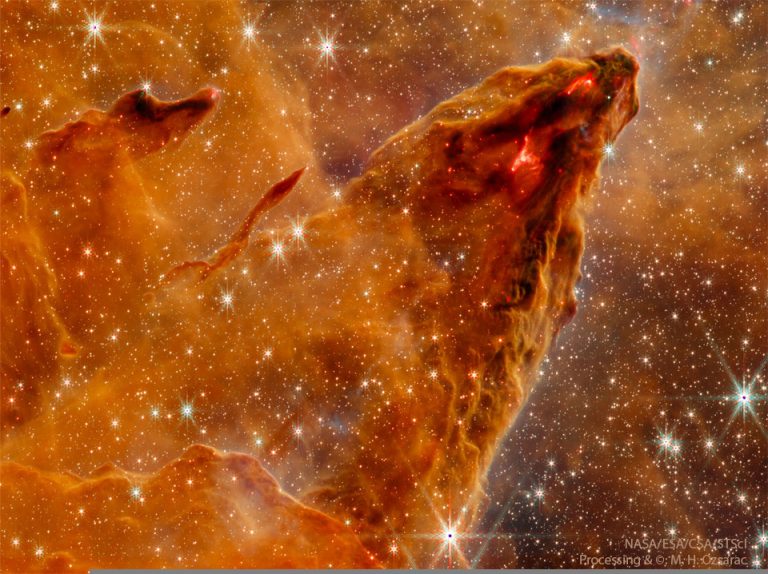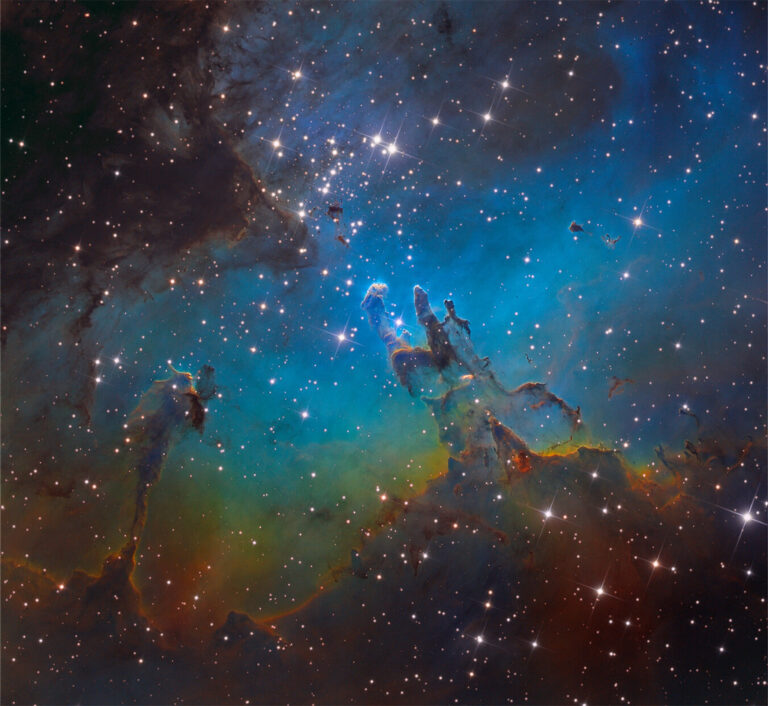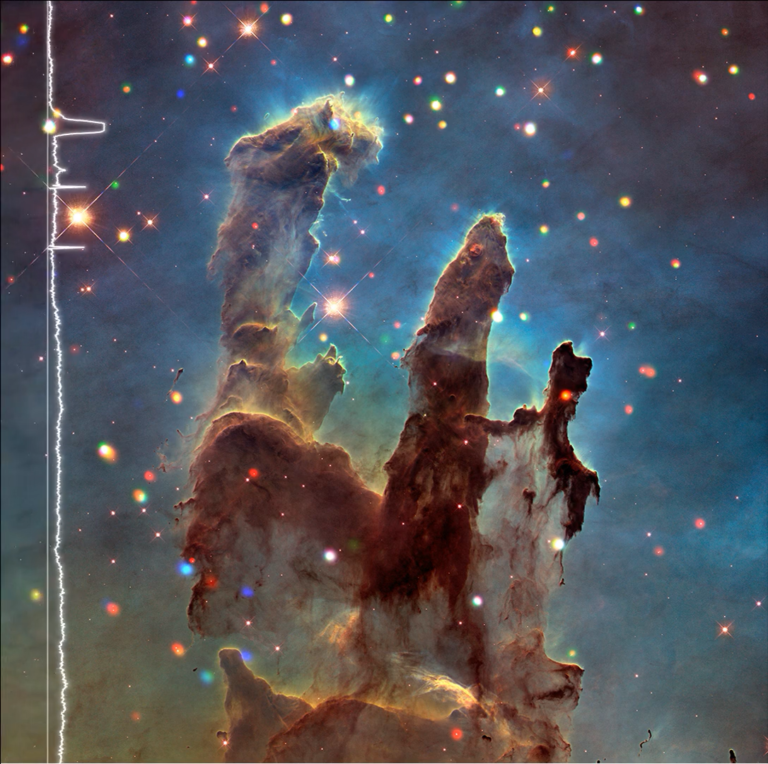M16: 创生之柱
Three large interstellar dust pillars are shown against a starfield and a multicolored glowing background. Please see the explanation for more detailed information.
三根巨大的星际尘埃柱映衬着星空和五彩斑斓的发光背景。有关更多详细信息,请参阅说明。

Three large interstellar dust pillars are shown against a starfield and a multicolored glowing background. Please see the explanation for more detailed information.
三根巨大的星际尘埃柱映衬着星空和五彩斑斓的发光背景。有关更多详细信息,请参阅说明。

2023年7月25日 The Eagle Nebula with X-ray Hot Stars Image Credit: X-ray: Chandra: NASA/CXC/SAO, XMM: ESA/XMM-Newton; IR: JWST: NASA/ESA/CSA/STScI, Spitzer: NASA/JPL/CalTech; Visible: Hubble: NASA/ESA/STScI, ESO; Image Processing: L. Frattare, J. Major, N. Wolk, and K. Arcand Explanation: What do the famous Eagle Nebula star pillars look like in X-ray light? To find out, NASA’s orbiting Chandra X-ray Observatory peered in and through these interstellar mountains of star formation. It was found that in M16 the dust pillars themselves do not emit many X-rays, but a lot of small-but-bright X-ray sources became evident. These sources are shown as bright dots on the featured image which is a composite of exposures from Chandra (X-rays), XMM (X-rays), JWST (infrared), Spitzer (infrared), Hubble (visible), and the VLT (visible). What stars…

2023年5月15日 M16: Eagle Nebula Deep Field Image Credit & Copyright: Gianni Lacroce Explanation: From afar, the whole thing looks like an eagle. A closer look at the Eagle Nebula, however, shows the bright region is actually a window into the center of a larger dark shell of dust. Through this window, a brightly-lit workshop appears where a whole open cluster of stars is being formed. In this cavity, tall pillars and round globules of dark dust and cold molecular gas remain where stars are still forming. Already visible are several young bright blue stars whose light and winds are burning away and pushing back the remaining filaments and walls of gas and dust. The Eagle emission nebula, tagged M16, lies about 6500 light years away,…

2022年12月6日 M16: A Star Forming Pillar from Webb Image Credit: NASA, ESA, CSA, STScI, Processing & Copyright: Mehmet Hakan Özsaraç Explanation: What’s happening inside this interstellar mountain? Stars are forming. The mountain is actually a column of gas and dust in the picturesque Eagle Nebula (M16). A pillar like this is so low in density that you could easily fly though it — it only appears solid because of its high dust content and great depth. The glowing areas are lit internally by newly formed stars. These areas shine in red and infrared light because blue light is scattered away by intervening interstellar dust. The featured image was captured recently in near-infrared light in unprecedented detail by the James Webb Space Telescope (JWST), launched late…

2022年10月4日 Star-Forming Eagle Nebula without Stars Image Credit & Copyright: Yannick Akar Explanation: The whole thing looks like an eagle. A closer look at the Eagle Nebula’s center, however, shows the bright region is actually a window into the center of a larger dark shell of dust. Through this window, a brightly-lit workshop appears where a whole open cluster of stars is being formed. In this cavity tall pillars and round globules of dark dust and cold molecular gas remain where stars are still forming. Paradoxically, it is perhaps easier to appreciate this impressive factory of star formation by seeing it without its stars — which have been digitally removed in the featured image. The Eagle emission nebula, tagged M16, lies about 6500 light years…

2022年8月12日 Portrait of the Eagle Nebula Image Credit & Copyright: Charles Bonafilia Explanation: A star cluster around 2 million years young surrounded by natal clouds of dust and glowing gas, Messier 16 (M16) is also known as The Eagle Nebula. This beautifully detailed image of the region adopts the colorful Hubble palette and includes cosmic sculptures made famous in Hubble Space Telescope close-ups of the starforming complex. Described as elephant trunks or Pillars of Creation, dense, dusty columns rising near the center are light-years in length but are gravitationally contracting to form stars. Energetic radiation from the cluster stars erodes material near the tips, eventually exposing the embedded new stars. Extending from the ridge of bright emission left of center is another dusty starforming column…

2021年9月9日 M16 Cose Up Image Credit & Copyright: Martin Pugh Explanation: A star cluster around 2 million years young surrounded by natal clouds of dust and glowing gas, M16 is also known as The Eagle Nebula. This beautifully detailed image of the region adopts the colorful Hubble palette and includes cosmic sculptures made famous in Hubble Space Telescope close-ups of the starforming complex. Described as elephant trunks or Pillars of Creation, dense, dusty columns rising near the center are light-years in length but are gravitationally contracting to form stars. Energetic radiation from the cluster stars erodes material near the tips, eventually exposing the embedded new stars. Extending from the ridge of bright emission left of center is another dusty starforming column known as the Fairy…

2020年12月28日 M16: Inside the Eagle Nebula Image Credit & Copyright: Nicolas Paladini Explanation: From afar, the whole thing looks like an Eagle. A closer look at the Eagle Nebula, however, shows the bright region is actually a window into the center of a larger dark shell of dust. Through this window, a brightly-lit workshop appears where a whole open cluster of stars is being formed. In this cavity tall pillars and round globules of dark dust and cold molecular gas remain where stars are still forming. Already visible are several young bright blue stars whose light and winds are burning away and pushing back the remaining filaments and walls of gas and dust. The Eagle emission nebula, tagged M16, lies about 6500 light years away,…

2020年12月06日 M16: Pillars of Star Creation Image Credit: NASA, ESA, Hubble Space Telescope, J. Hester, P. Scowen (ASU) Explanation: These dark pillars may look destructive, but they are creating stars. This pillar-capturing image of the inside of the Eagle Nebula, taken with the Hubble Space Telescope in 1995, shows evaporating gaseous globules (EGGs) emerging from pillars of molecular hydrogen gas and dust. The giant pillars are light years in length and are so dense that interior gas contracts gravitationally to form stars. At each pillars’ end, the intense radiation of bright young stars causes low density material to boil away, leaving stellar nurseries of dense EGGs exposed. The Eagle Nebula, associated with the open star cluster M16, lies about 7000 light years away. The pillars…

2020年9月30日 Sonified: Eagle Nebula Pillars Image Credit: NASA, ESA, & The Hubble Heritage Team (STScI/AURA); Sonification: NASA, CXC, SAO, K. Arcand, M. Russo & A. Santaguida Explanation: Yes, but have you ever experienced the Eagle Nebula with your ears ? The famous nebula, M16, is best known for the feast it gives your eyes, highlighting bright young stars forming deep inside dark towering structures. These light-years long columns of cold gas and dust are some 6,500 light-years distant toward the constellation of the Serpent (Serpens). Sculpted and eroded by the energetic ultraviolet light and powerful winds from M16’s cluster of massive stars, the cosmic pillars themselves are destined for destruction. But the turbulent environment of star formation within M16, whose spectacular details are captured in…